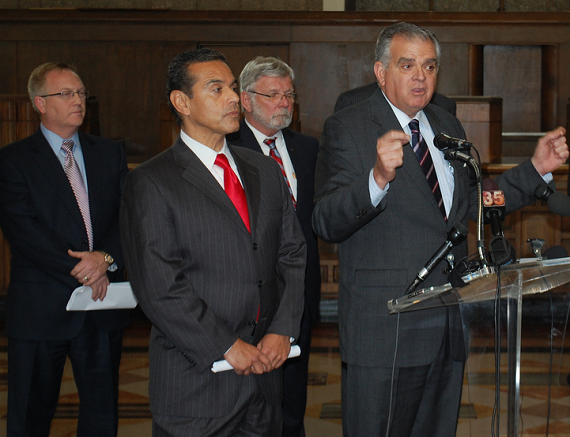As national press sharpens their focus on Mayor Antonio Villaraigosa's cheat sheet, there's been way too much discussion of Charlie Sheen and other assorted scandals. What's too often missing is a discussion of the Mayor's own transportation record. To try and help our friends in the legacy media, L.A. Streetblog proudly presents the two-part, "Mayor Villaraigosa Transportation Cheat Sheet." Today we'll look at policy and project accomplishments. Tomorrow we'll look at some narratives including a look at the story on whether a broken elbow changed the city's bike policies, tomorrow.

We should note that despite our good relationship with the mayor and his press office, we have no inside information. A request for a formal statement on the USDOT rumors was met with a "The best I can do for you for now is to send you to the White House for those inquiries."
But the rumors persist, and to that end, we present...
The Mayor's Overall Transportation Record:
First, read this The Subway Mayor published by the L.A. Weekly from 2005. Shortly after taking office, the second-largest print publication in Los Angeles took a look at the Mayor's transportation platform. While the news paper didn't exactly scoff, it cast the odds of accomplishing his transit vision as pretty long.
Next, read this three part interview: Building a New Transportation System, The Subway Mayor Triumphant, and Streetcast: Audio from the Interviews.
There's many negative things that will be said about Villaraigosa if he is nominated to be secretary of transportation, but there is no denying he has an excellent record on transportation. Any reporter reading this who would like to discuss the Mayor's track record "on the record" should email damien@streetsblog.org In short:
Metro aka Los Angeles County Metropolitan Transit Authority, is building and studying more rail and rapid bus projects than ever before. In just the past two years, a light rail line connecting Culver City to Downtown Los Angeles and a four mile extension of the San Fernando Valley's Bus Rapid Transit Line opened to the public. The next ten major transit projects, including extending the aforementioned light rail to Santa Monica, are at least partially funded through Measure R, a sales tax passed by L.A. County voters in 2008 to fund transportation projects.
For bicyclists, the city passed a "surprisingly progressive" bicycle plan that promised over 1600 miles of new bikeways in the next three decades in 2011. The city has already striped over 100 of those miles and is using a new state law to speed up the environmental review for additional miles. Amazingly, Los Angeles is now a "bronze level city" for bike friendliness according to the League of American Cyclists.
But it's not the local projects that make Villaraigosa stand out as a potential candidate, it's his leadership on issues on federal transportation funding formulas, that has earned high marks. Villaraigosa spear-headed the 30/10 plan as Mayor of Los Angeles which seeked a series of changes in federal law that would allow Metro to borrow money from the federal government to build all 30 years of Measure R projects in the next decade. When he became chair of the Conference of Mayors, he nationalized the campaign and re-branded it America Fast Forward.
While he didn't get everything he wanted, provisions of America Fast Forward were found in both drafts of the new federal transportation bill, one written by liberal Senator Barbara Boxer and the other by Conservative Congress Member John Mica. In fact, when progressives were piling on the Mica bill, Villaraigosa appeared on a conference call praising the America Fast Forward provisions in the bill, showing some bi-partisan courage.
In total, the change in policies that occurred as a direct result of his lobbying .
- Expands funding for TIFIA to $750 million in FY 2013 and $1 billion in FY 2014.
- Increases the share of project costs that TIFIA can cover from 33 percent to 49 percent
- Enables US DOT to make loans to a group of related projects
- Authorizes US DOT to make upfront conditional commitments to projects through Master Credit Agreements making TIFIA assistance more predictable for larger, multi‐year phased capital programs.
- Authorizes US DOT to allow limited interest rate buydowns.
- Provides $105 billion (roughly $54 billion per year) for the nation’s surface transportation programs.
In conclusion, Villaraigosa's transportation record isn't perfect, even the Mayor's Office gives itself some red marks. But should he be nominated to head the USDOT, a debate on policy will be more informative than one on speculation and innuendo. Such a discussion should start with some of the points outlined above.






